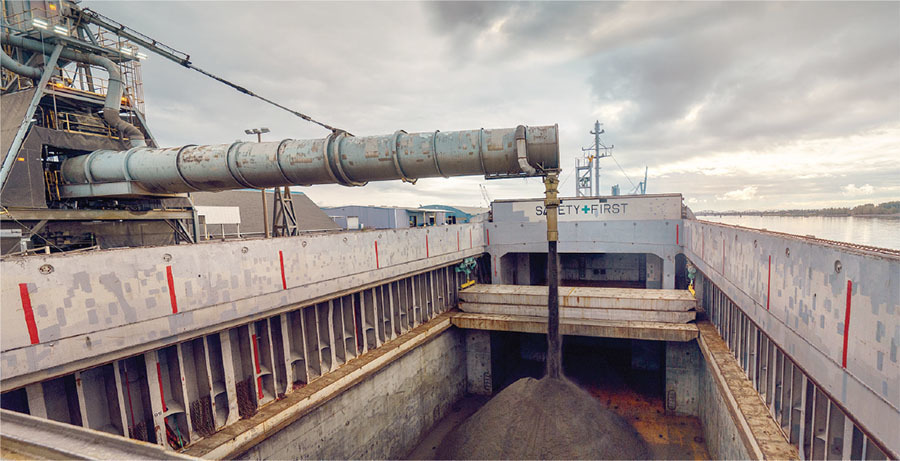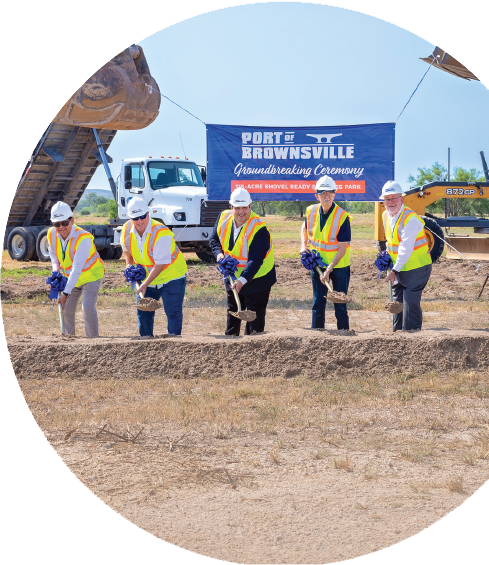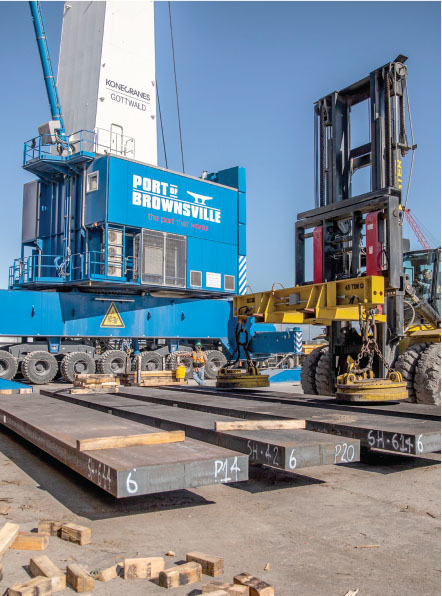
Two ports draw new business by selling their strengths and building relationships
As chief commercial officer for the Port of Vancouver USA, Alex Strogen is used to fielding questions about his port. The strange thing is that he’s often asked about another port located in a different country, some 300 miles away.
Strogen said that, at least once a week, someone will call the port in Vancouver, Wash., by mistake, seeking to reach the Port of Vancouver in British Columbia, Canada.
“It happens all the time,” Strogen said with a laugh. “When you’ve got a big brother, if you will, like Vancouver, B.C., which is an amazing port in an amazing city that everybody knows, it can be incredibly hard to differentiate yourself.”
Strogen is happy to point those callers in the right direction, but as the green-energy movement gains momentum, the Washington port is raising its own profile and has no intention of being “the other Port of Vancouver.”

In May, the port ratified a 30-year lease agreement with Vancouver Bulk Terminal (VBT), a joint venture between Nautilus International Holding Corp. and Neltume Ports. VBT began operating the port’s Terminal 2 bulk facility on June 1, launching one of the “most sustainable and efficient port-terminal options on the U.S. Pacific Coast for exporters of minerals and clean bulk,” Nautilus said in a statement.
For the Port of Vancouver USA, acquiring that new anchor tenant wasn’t the result of one lucky break on a cold call to drum up new business. Quite the opposite, Strogen said. It was the result of years of strategic communication and collaboration, selling the strengths of the port and the surrounding area to potential customers, and working with regulators to streamline onboarding.
That approach is paying off for ports across North America, enabling them to diversify their revenue streams and tenant rosters and position themselves for future success.
Products in Demand
Since it doesn’t handle containers, the Port of Vancouver USA doesn’t play a large role in getting consumer products to retail stores and fulfillment centers. Instead, the port, established in 1912, primarily is a bulk import-and-export facility handling commodities such as grain, soybeans, corn, mineral ores, concentrates, fertilizers, clays, bauxite, and agricultural products.
One key product for the port is copper concentrate, which is used in solar panels, wind turbines, electric vehicles and their batteries, power transmission and distribution systems, hydroelectric equipment, and geothermal systems.
Strogen said Terminal 2 provides the location and technical capabilities for handling a broad range of bulk commodities with safety, speed, and efficiency in support of the future green economy.
“Copper concentrate is probably the most critical mineral that we handle at the port, notably because of the world’s ferocious appetite for copper as we move toward this electrified future,” he said. “The demand for copper is surging, and as the primary gateway for copper concentrate in the United States, it’s a big role for us to play to help keep that green supply chain going.”
The VBT lease agreement was an important development for the Port of Vancouver USA that should help the facility to attract more business, Strogen said. And like the green-energy movement, the deal was a long time in the making.
Strogen said the port has spent years building relationships with the small subset of companies involved in mining, transporting, or using minerals and raw ingredients such as bentonite clay.

During many phone calls and meetings, the port’s environmental, regulatory, and commercial teams emphasized its strategic advantages, including its geographic location and its strong track record of moving these materials, he said.
The Rocky Mountain West is home to many of the U.S. mines producing these materials, and as the farthest inland port in the Pacific Northwest, located on the Columbia River, the Port of Vancouver USA is “incredibly well positioned to take advantage of these critical minerals,” Strogen said. The port’s location also makes it ideal for companies shipping large wind-energy components inland, he said.
Another selling point is that the Port of Vancouver USA has room to grow. Unlike some West Coast ports that are hemmed in by development, the port has hundreds of acres of land available for tenants looking to stretch out, Strogen said.
The port’s commercial team spends considerable time on the road, attending industry events and visiting the headquarters of potential customers such as mining companies, traders, shipping lines, and intermediaries, Strogen said. To build key relationships that stand the test of time, you have to show up in person and press the flesh, he said.
“I would love to tell you that you can develop these relationships over the phone, but the reality is that it’s absolutely impossible,” Strogen said. “When you’re talking about this type of capital investment and assuming this type of role in their overall success – being the gateway for their product to the global market – it’s critical to be in front of them, face to face, building that relationship literally over years.”
Once the dotted lines are signed, the work doesn’t stop, Strogen said. Since port tenants typically stay for decades, the port must continue to seek out ways to grow those partnerships and increase business opportunities, he said.
Strogen said the port’s success has made it a resource for industry stakeholders seeking the latest information about environmental regulations and the labor market in the Pacific Northwest, helping them to stay ahead of the curve.
“One of the most rewarding things is when we can go to an industry conference and we are sought out by our customers to share those insights with them,” he said. “That’s when you know you’ve been successful.”
Since the Terminal 2 facility was almost 40 years old, the port knew it would need significant upgrades to handle commodities in the most efficient and sustainable way possible. The port ultimately selected VBT as a partner after evaluating the company’s detailed plans for building out the facility, Strogen said.
In accordance with best practices, plans for Terminal 2 involve the use of a rotainer system, a specialized conveyance that, once loaded with mineral bulk, can rotate 180 degrees for safe and efficient discharge into a ship’s hull. The rotainer system’s unique design will prevent materials from sticking to its surfaces, Strogen said.
The benefits of rotainer usage include dust suppression, a reduction in cargo losses, the mitigation of cross-contamination, and reduced handling time, which leads to lower costs, he added.
“Ultimately, our goal is to not only mitigate any fugitive dust but also to keep the supply chain moving,” he said.

Riding a Winning Streak
Almost 2,400 miles to the southeast is another port with plenty of elbow room and a willingness to doggedly pursue new business.
In 2021, the Port of Brownsville in South Texas climbed 11 spots to rank 55th among U.S. maritime ports in terms of waterborne cargo tonnage, according to the most recent report from the U.S. Army Corps of Engineers. That year, the port transported 8.9 million tons of commodities via its ship channel, up 30% from the prior year.
Eduardo A. Campirano, port director and chief executive, said the port has set a record for total cargo volume in each of the past four years, moving 15.2 million tons last year, so he expects Brownsville to vault several positions up the list when the next rankings come out.
Still, with a footprint of 40,000 acres, Brownsville is the largest land-owning public port authority in the country, so there’s plenty of room for growth at the only deep-water seaport sitting directly on the U.S.-Mexico border. Campirano said that in seeking out new tenants, that acreage is a main selling point for the port.
“South Texas is one of the poorest regions of the country, so we’re not going to bring a lot of money to the table, but we’re able to leverage our land to make it attractive for tenants to locate here and expand here,” he said. “In many respects, we wind up being the facilitator. We’re not an operating port, but we certainly have access to all the services that a tenant would need to be successful.”
The Port of Brownsville rolled out the welcome mat in June, breaking ground on a 118-acre shovel-ready business park. With ample storage capabilities, access to multimodal transportation and logistics services from the port, the business park eventually will become a “dynamic ecosystem for companies to collaborate, innovate, and flourish,” the port said in a statement.

Impactful Projects
The business park is just one of the major recent developments for Brownsville. Current capital projects include expanding patios, rehabilitating docks, and deepening the Brownsville Ship Channel to 52 feet from 42 feet. The increased draft will allow for larger ships to bring heavier loads to the port, including large wind-energy components that have become a staple for the port.
The deeper channel will yield costs savings for businesses and provide navigational safety improvements for commercial shipping in South Texas, Campirano said. That project is already helping the port to attract new business. The Mexican company Forza Steel is building a $60 million manufacturing facility there, and NextDecade’s multibillion-dollar Rio Grande LNG project will be the largest privately funded infrastructure project in Texas.
NextDecade recently made a final investment decision to begin Phase 1 of Rio Grande LNG, constructing the first three liquefaction trains. At full scale, the project will deliver enough energy to heat and cool approximately 34 million U.S. households annually, according to NextDecade. The project will use carbon-capture technology to greatly reduce greenhouse-gas emissions, the company added.
NextDecade is helping to fund the channel-deepening project, Campirano said. The port has begun working on the upland disposal sites so that dredging can commence by year’s end, with the project likely extending through 2026, he said.

The project will allow one of the port’s core customers, Ternium Mexico SA, to import larger quantities of steel slab from Europe, South America, and Asia. The steel-manufacturing giant is a key supplier to the automotive, appliance, and construction industries, and the port’s ability to accommodate larger ships is an important component of its growth plan.
In June, Ternium said it will invest $3.2 billion to build a new steelworks and cold-rolling facility at the company’s existing site in Pesquería, Mexico. Ternium said it’s the largest capital investment in the company’s history. With multiple steel furnaces, the new facility will greatly augment Ternium’s production capacity, enabling it to capitalize on strong international demand.
“The channel-deepening project isn’t just for our new tenants,” Campirano said. “It’s also for our existing customers that want to grow with us, so we’re very excited to be able to get that project started.”
Brownsville has begun building out the infrastructure for its new business park, including utilities, roads, and data services, and it hopes to complete that work by June 2024, Campirano said. New tenants would then build their facilities according to their needs. So far, interest in shovel-ready sites has been strong, and some prospective tenants are seeking sites with existing buildings so they can begin operations sooner, he said.

Warehousing operations, which the port needs, could be up and running six to nine months after the port readies a construction site for a new tenant, depending on the tenant’s timetable, Campirano said. The business park provides an opportunity for U.S. businesses to nearshore their supply chains, a key consideration given the supply-chain shocks caused by COVID-19 and conflict abroad.
With so many large projects in the pipeline, the port is growing at an impressive rate, and that’s not by accident, he said.
“We’ve been on a roll lately,” Campirano said. “A lot of our business is related to trade with Mexico, so we spend a lot of time there. We’ve been in the news a lot recently, but we don’t hesitate to knock on doors, go to trade shows, and make cold calls. There’s no phone call we won’t take.
“The great thing is that because of everything that’s happening here, people are starting to come to us and see what we’ve got to offer, so that’s been a big plus for us. These developments have come to fruition after years of hard work, so we’re on a good streak right now.”
 AAPA Seaports
AAPA Seaports


